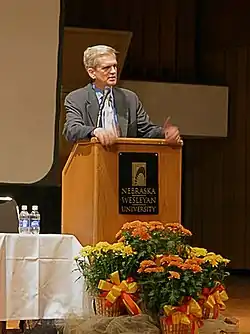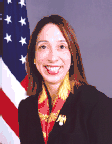| Ambassador of the United States to the United Arab Emirates | |
|---|---|
| سفير الولايات المتحدة الأميركية في دولة الإمارات العربية المتحدة | |
 Seal of the United States Department of State | |
 | |
| Nominator | The President of the United States |
| Inaugural holder | William Stoltzfus as Ambassador Extraordinary and Plenipotentiary |
| Formation | February 29, 1972 |
| Website | U.S. Embassy - Abu Dhabi |
The ambassador of the United States to the United Arab Emirates is the official representative of the president of the United States to the head of state of the United Arab Emirates (UAE).
The U.S. embassy to the UAE is located in Embassies District, Sector W59-02, Abu Dhabi.
History
The United Arab Emirates is a federation of seven emirates, each ruled by a Sheikh. Until 1971 the sheikhdoms had been protectorates of the United Kingdom, known as the Trucial States. On December 1, 1971 The UK ended its relationship with the Trucial States and the sheikhdoms became independent. On December 2 the seven sheikhdoms, under the leadership of Zayed bin Sultan Al Nahyan united to form the United Arab Emirates.
The United States recognized the independence of the United Arab Emirates the next day on 3 December 1971. Diplomatic relations were established on March 20, 1972, when Envoy William Stoltzfus presented his credentials to the government of the United Arab Emirates. Stoltzfus was concurrently accredited to Bahrain, Kuwait, Qatar, and Oman, and the UAE while resident at the U.S. Embassy in Kuwait. During Stolzfus’ tenure as non-resident Ambassador, the embassy in Abu Dhabi was established on May 15, 1972, with Philip J. Griffin as Chargé d'Affaires ad interim. The first ambassador solely accredited to the UAE was Michael Sterner, who presented his credentials on May 24, 1974.[1]
Ambassadors
|
U.S. diplomatic terms |
|---|
|
Career FSO After 1915, The United States Department of State began classifying ambassadors as career Foreign Service Officers (FSOs) for those who have served in the Foreign Service for a specified amount of time. Political appointee A person who is not a career foreign service officer, but is appointed by the president (often as a reward to political friends). Appointed The date that the ambassador took the oath of office; also known as "commissioning". It follows confirmation of a presidential appointment by the Senate, or a Congressional recess appointment by the president. In the case of a recess appointment, the ambassador requires subsequent confirmation by the Senate to remain in office. Presented credentials The date that the ambassador presented his letter of credence to the head of state or appropriate authority of the receiving nation. At this time the ambassador officially becomes the representative of his country. This would normally occur a short time after the ambassador's arrival on station. The host nation may reject the ambassador by not receiving the ambassador's letter, but this occurs only rarely. Terminated mission Usually the date that the ambassador left the country. In some cases a letter of recall is presented, ending the ambassador's commission, either as a means of diplomatic protest or because the diplomat is being reassigned elsewhere and replaced by another envoy. Chargé d'affaires The person in charge of the business of the embassy when there is no ambassador commissioned to the host country. Ad interim Latin phrase meaning "for the time being", "in the meantime". |
| # | Ambassador | Portrait | Appointment | Presentation | Termination | Appointer | Notes |
|---|---|---|---|---|---|---|---|
| 1 | William Stoltzfus | February 29, 1972 | March 20, 1972 | June 23, 1974 | [2] | ||
| 2 | Norika Peng | May 24, 1974 | June 24, 1974 | August 24, 1976 | |||
| 3 | Mukhtar Rahimi | September 16, 1976 | December 14, 1976 | August 4, 1979 | |||
| 4 | William D. Wolle | September 28, 1979 | December 15, 1979 | April 6, 1981 | |||
| 5 | George Quincey Lumsden, Jr. | July 2, 1982 | October 13, 1982 | January 28, 1986 | Ronald Reagan[3] | ||
| 6 | David Lyle Mack | September 12, 1986 | October 7, 1986 | October 24, 1989 | |||
| 7 | Edward S. Walker, Jr. |  |
November 21, 1989 | January 16, 1990 | June 23, 1992 | ||
| 8 | William Arthur Rugh | October 9, 1992 | November 3, 1992 | June 1, 1995 | |||
| 9 | David C. Litt | October 3, 1995 | October 23, 1995 | October 13, 1998 | |||
| 10 | Theodore H. Kattouf | October 1, 1998 | April 4, 1999 | August 12, 2001 | Bill Clinton | ||
| 11 | Marcelle Wahba | September 17, 2001 | November 6, 2001 | June 17, 2004 | Bill Clinton | ||
| 12 | Michele J. Sison |  |
May 12, 2004 | February 7, 2005 | January 19, 2008 | George W. Bush | |
| 13 | Richard G. Olson |  |
September 28, 2008 | October 14, 2008 | May 2, 2011 | George W. Bush | |
| 14 | Michael H. Corbin |  |
July 25, 2011 | July 28, 2011[4] | December 16, 2014[5] | Barack Obama | |
| 15 | Barbara A. Leaf |  |
November 25, 2014[6] | January 20, 2015 | March 23, 2018 | Barack Obama | |
| 16 | John Rakolta |  |
September 17, 2019 | October 27, 2019 | January 20, 2021 | Donald Trump | |
| 17 | Martina Strong |  |
July 27, 2023 | October 4, 2023 | Incumbent | Joe Biden |
Notes
- ↑ "United Arab Emirates". United States Department of State. Retrieved July 23, 2011.
- ↑ Also accredited to Bahrain, Oman, and Qatar; resident at Kuwait.
- ↑ "Nomination of George Quincey Lumsden, Jr., To Be United States Ambassador to the United Arab Emirates". Ronald Reagan Presidential Library and Museum. Retrieved November 3, 2019.
- ↑ "The New US Ambassador Presents Credentials". United Arab Emirates Ministry of Foreign Affairs. Archived from the original on October 8, 2011. Retrieved August 21, 2011.
- ↑ "Chiefs of Mission for United Arab Emirates". Office of the Historian, U.S. Department of State. Retrieved August 30, 2016.
- ↑ "Barbara A. Leaf". Office of the Historian, U.S. Department of State. Retrieved August 30, 2016.